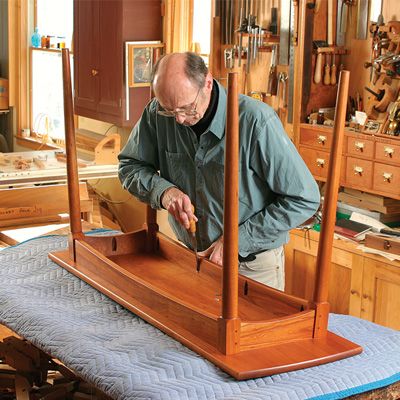Keeping Tabletops Flat
Three ways to keep a top from cupping while letting it move with the seasons
Synopsis: Any well-made solid table will have a flat top when new. But how do you keep that top from warping with seasonal changes in humidity? Contributing editor Christian Becksvoort explains why the properties of wood make it liable to warp and how your choice of lumber has a lot to do with whether a table will cup or twist. Then, Becksvoort shares three ways to keep a top stable and flat for years to come—using aprons, cleats, or breadboard ends.
Any well-made solid-wood table has a dead-flat top when new. And you expect that top to stay flat for years to come. But unless the maker follows some basic rules, the top is likely to warp down the road, courtesy of the humidity in the air. That said, if you understand how to assemble, finish, and restrain these wide panels, they will be flat when the next millennium arrives.
Understanding tabletop warp
Moisture entering the cell walls of wood causes the cells to expand, while moisture leaving the cells makes the walls contract. Warp results when different areas of the wood expand and contract at different rates. One common form of warp, called cup, occurs when one side of a board expands and contracts at a different rate from the other. All else being equal, cup tends to become more pronounced as boards get wider.
Quartersawn vs. flatsawn—When viewed from the end of a board, the growth rings can tell you a lot about whether the board is likely to cup. If the rings meet the face at between 45° and 90°, the wood is considered quartersawn. The rings on flatsawn wood meet the face at less than 45°.
Quartersawn wood moves only about half as much as flatsawn and is much less likely to cup. So quartersawn wood often is a good choice for tabletops that cannot accept a mechanical support to help keep them flat.
When edge-gluing several flatsawn boards to create a tabletop, some woodworkers prefer to alternate the growth rings (concave toward the top, then concave toward the bottom, and so on), while others prefer to run them in the same direction. But after 40 years of gluing up hundreds of tabletops and thousands of panels, I find that grain orientation really makes little difference. My priority is to position sapwood and blemishes on the underside of the table, which usually means that the growth rings are concave toward the top.
From Fine Woodworking #183
For the full article, download the PDF below:
Fine Woodworking Recommended Products

Bessey EKH Trigger Clamps

Stanley Powerlock 16-ft. tape measure























Log in or create an account to post a comment.
Sign up Log in